Baekundonggyegok Valley (백운동계곡)
0m 7960 2019-12-05
Baekdam-ro, Buk-myeon, Inje-gun, Gangwon-do
+82-33-462-2554
Baekundonggyegok Valley flows 5 km from the valley of Deoktaesan Mountain and Seongaksan Mountain. There are oak trees and maple trees growing in thick clusters and clean waters flowing nearby.
Baekundonggyegok Valley stands between the seven brother stones and Yongdampokpo Falls, and starting from this point to Gwuiddegicheong Peak is Baekundonggyegok Valley. The rocks are connected in a long line and ponds can be seen here and there. On each side of the valley there are rock walls, which make for some unforgettable scenery. Baekundonggyegok Valley maintains its natural beauty and majesty, which attracts many hikers. Especially from the middle point where Jikbaekun and Gokbaekun combine to make the Gugokgyegok Valley the most magnificent scenery of Baekundonggyegok Valley can be seen. The largest waterfall of Baekundonggyegok Valley, called Baekunpokpo Falls, is about 30 meters high. The upper part of the waterfall has rocks lined up in a long line. The landscape of Seoraksan Mountain seen from this point is the representative landscape of the mountain.
Baekdamsa Temple (백담사)
3.7 Km 26525 2021-05-03
746, Baekdam-ro, Inje-gun, Gangwon-do
+82-33-462-6969
Located within Seoraksan Mountain, Baekdamsa Temple was built by Monk Ja Jang (590~658) during the reign of Queen Jindeok (647-654), 28th ruler of the Silla Kingdom. The temple was burnt down and moved several times until 1957 when it was rebuilt to the current location. There are various treasures and hermitages in the temple. Many famous people have visited the temple including Manhae Han Yong-un, a strong independence activist and poet. There are countless number of rock towers in front of the temple by the creek where visitors come to stack stones while praying for their wishes.
Seorak Special Tourist Zone (설악 관광특구)
3.7 Km 7795 2020-03-25
Sokcho-si, Gangwon-do
+82-33-249-2775
Seorak Special Tourist Zone is a vast zone included in 3 administrative districts, encompassing the entirety of Seoraksan Mountain. In this zone, visitors have various ways to enjoy Seoraksan Mountain and the natural environment of the East Sea region.
Sokcho, which occupies the largest area in the zone, comes first when talking about Seoraksan National Park. Tourists can appreciate the picturesque scenery of the sea and coastal lakes as well as the mountain scenery of Seoraksan Mountain. Hikers can climb the mountain or ride a cable car. Sokcho Beach is a hot spot that attracts young people who fill the place with energy and life all through the summer.
Abai Village, which appeared in several TV dramas for its unique atmosphere, and Sokcho Jungang Market offer local specialties, such as abai sundae (Korean sausage) and dak gangjeong (glazed fried chicken bites).
Goseong, which is bordered by Seoraksan Mountain and Geumgangsan Mountain, is part of the Northern Limit Line (NLL) that offers a unpolluted, beautiful landscape around the Demilitarized Zone (DMZ). Hwajinpo Beach near Hwajinpo Lake, which is a lagoon, and Songjiho Beach near Songjiho Lake are the best places to spend a peaceful vacation. At Hwajinpo Lake, tourists can visit the summer house used by the first South Korean President Syngman Rhee and Castle of Hwajinpo, visited by the former North Korean leader Kim Il-sung before the division of the Korean Peninsula. Lastly, although it is a relatively small part of Seorak Special Tourist Zone, Yangyang has resources for mountain tourism and maritime culture, such as Seoraksan National Park and Naksan Provincial Park. Naksan Beach, Naksansa Temple and Hajodae are popular tourist sites. It is also famous as a district producing high quality pine mushroom.
* Current State of Seorak Special Tourist Zone
1) Districts Covered: Areas around Sokcho-si and parts of Goseong and Yangyang-gun, Gangwon-do
2) Area: 138.2k㎡(Sokcho 104.9k㎡, Goseong 30.5k㎡, Yangyang 2.8k㎡)
* Tourist Attractions
Seoraksan National Park, Sokcho Beach, Naksan Provincial Park, Hwajinpo Lake, Songjiho Lake, Hajodae Pavilion, Naksansa Temple, Osaek Mineral Spring, etc.
Jangsudae Pavilion (장수대)
3.9 Km 8983 2020-03-24
4193, Seorak-ro, Inje-gun, Gangwon-do
+82-33-463-3476
Jangsudae Pavilion was completed on October 1, 1959 to commemorate the great victory of the battle held at Seoraksan Mountain during the Korean War. It serves as a resting spot for visitors who hike up the park to visit attractions nearby such as the Daeseung Falls, Oknyeotang Spring, Gamatang Spring, Hangyesanseong Fortress, and Haneulbyeok Wall. The pavilion is built in a traditional Korean style and considered as an excellent hermitage in terms of both structure and size. The surrounding nature consisting of mountain cliffs and pine forest makes the building stand out even more.
Bongjeongam Hermitage (Inje) (봉정암(인제))
5.8 Km 36133 2024-02-28
1700 Baekdam-ro, Buk-myeon, Inje-gun, Gangwon-do
Bongjeongam Hermitage, situated at the highest point of Seoraksan Mountain, stands at 1,244 meters above sea level. Due to its elevation, one can witness snow-covered landscapes well into late May. The temple is 10.6 kilometers from the entrance of Baekdamsa Temple and requires 4-5 hours of steep climbing to reach. The view from Bongjeongam Hermitage is breathtaking, but the view of Seoraksan Mountain from the Shrine of Sakyamuni Buddha's Sarira is equally unmissable.
Seoraksan Heullimgol Valley (설악산 흘림골)
6.0 Km 4277 2024-02-16
San1-71, Osaek-ri, Seo-myeon, Yangyang-gun, Gangwon-do
Yangyang’s Heullimgol Valley, named for its cloud-like, foggy appearance due to the surrounding high mountains and deep valleys, offers a spectacular view and serves as the gateway to Deungseondae. This spot provides an expansive view of the southern side of Seoraksan Mountain. Notable sites near Heullimgol Valley include Yeosimpokpo Falls, Deungseondae, Deungseonpokpo Falls, Geumgangmun Gate, and Jujeongol Valley. Access to Heullimgol Valley is strictly limited to 5,000 visitors per day, with entry based on time reservations. Therefore, visitors must make a reservation through the Korea National Park Service's reservation system before visiting.
Baekdamgyegok Valley (백담계곡)
7.0 Km 15757 2021-06-25
150, Baekdam-ro, Inje-gun, Gangwon-do
+82-33-801-0977
Baekdamgyegok Valley stretches over an eight kilometer section from Baekdamsa Temple to Yongdae-ri in Inje-gun. The valley has a road, but it is closed to general traffic. The valley is located within Seoraksan National Park. The stream running through the valley is wide and deep. The name of the valley comes from the claim that there are one hundred ('baek' in Korea) pools ('dam') of water along the valley. Baekdamgyegok Valley features clean water and lush forests.
Osaengnyeong (Hangyeryeong) Pass (오색령(한계령))
7.1 Km 9864 2021-04-12
Seo-myeon, Yangyang-gun, Gangwon-do
+82-33-672-2883
This 1,004 m-high pass connects Seo-myeon of Yangyang-gun and Buk-myeon and Girin-myeon of Inje-gun, at the border between Naeseorak and Namseorak. The people of Yangyang know the pass as Osaengnyeong, while in Inje it is known as Hangyeryeong. Yi Jung-hwan, a late Joseon period scholar and the author of the geographical text Taengniji (On Selecting a Village), counted Osaengnyeong Pass as the first and the foremost of the six famous passes in Gangwon-do. Indeed, Osaengnyeong Pass was the route through which essential supplies were transported from Yangyang (in Yeongdong) to Inje (in Yeongseo region), and the rough pass taken by the people of Yangyang on the way to Seoul. Its presence in the folklore of the region can be seen in the popular song Hangyeryeong, which speaks to the difficulties of those who had to climb the pass. Hangyeryeong Road was opened in 1981, and today’s National Road No. 44 is famous for being a driving course through the beauty of Seoraksan Mountain. This is also the starting point of the shortest route to Daecheongbong Peak, the highest peak in Seoraksan Mountain, and the trail to the summit of Jeombongsan Mountain.
Baekdam Soft Bean Curd (백담순두부)
7.9 Km 16327 2024-03-15
19 Baekdam-ro, Buk-myeon, Inje-gun, Gangwon-do
This restaurant is a showcase for Inje’s celebrated culinary offering: Grilled Dried Pollack. The pollack is prepared through a natural drying process in the brisk winter winds, which gives it a salty flavor and a satisfying chewy texture. This makes it a popular choice as both an accompaniment to drinks and as a side dish on Korean dining tables. Here, it is grilled to perfection with a coating of red pepper paste, offering a flavorful experience with a reduced fishy smell and a delightful sweet and tangy taste. Also featured on the menu are the Soft Bean Curd Set Menu and the Wild Vegetable Bibimbap. The soft and warm bean curd, along with bibimbap—a harmonious mix of freshly-grown wild vegetables from Gangwon State topped with spicy red pepper paste—each provide a nutritious wholesome meal.
Seoraksan Osaek Jujeongol Valley (설악산 오색주전골)
8.1 Km 18829 2024-02-29
Yaksu-gil, Seo-myeon, Yangyang-gun, Gangwon-do
+82-33-672-2883
Osaek Jujeongol Valley in Seoraksan Mountain is renowned for its vibrant autumn maple leaves. The area features a 7-kilometer trail stretching from Oksaek Mineral Spring to Yongsopokpo Falls, accessible to all visitors. The valley boasts stunning scenery, with a mix of valleys and rock formations. When the autumn leaves begin to change colors, the landscape turns into a breathtaking masterpiece.

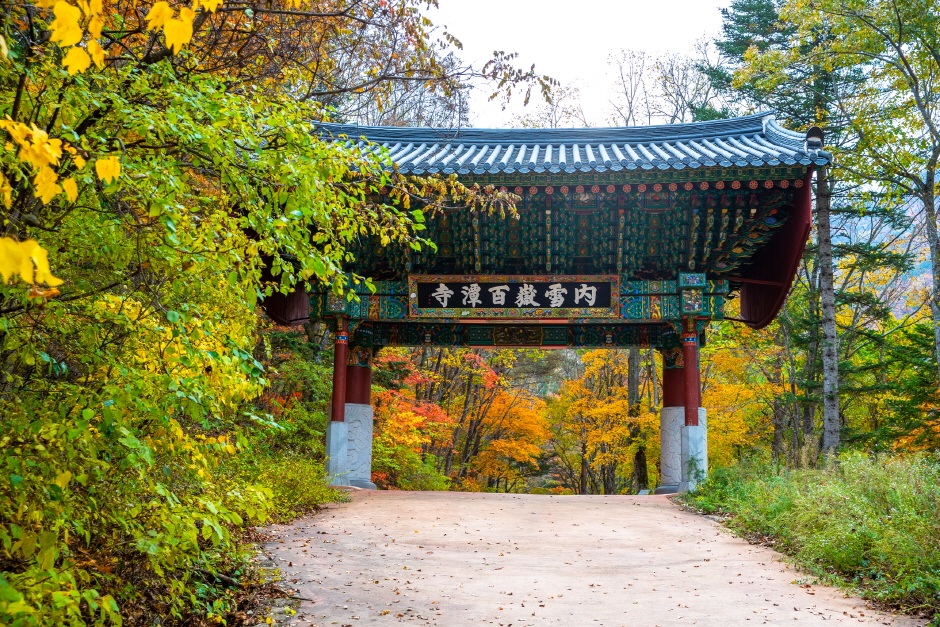
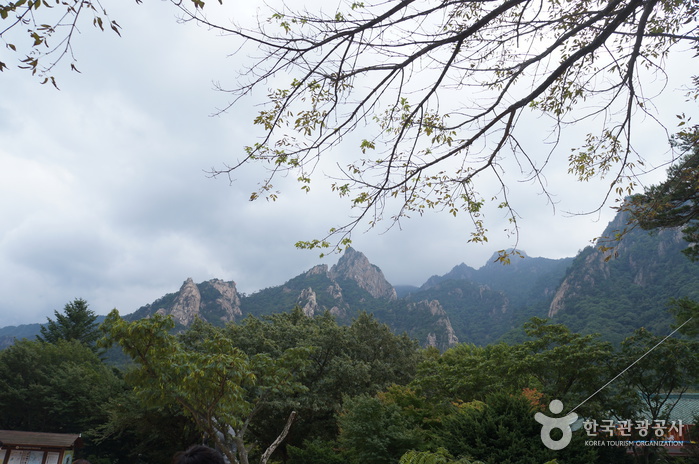
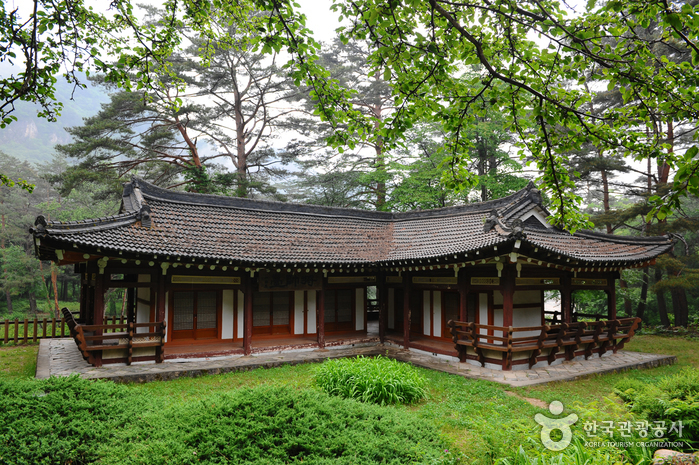
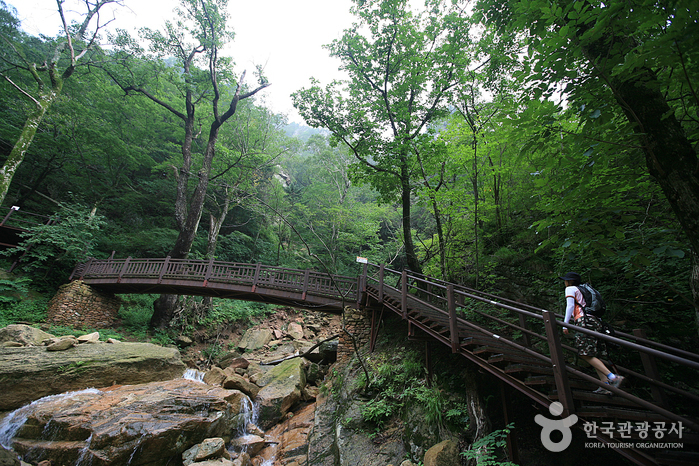
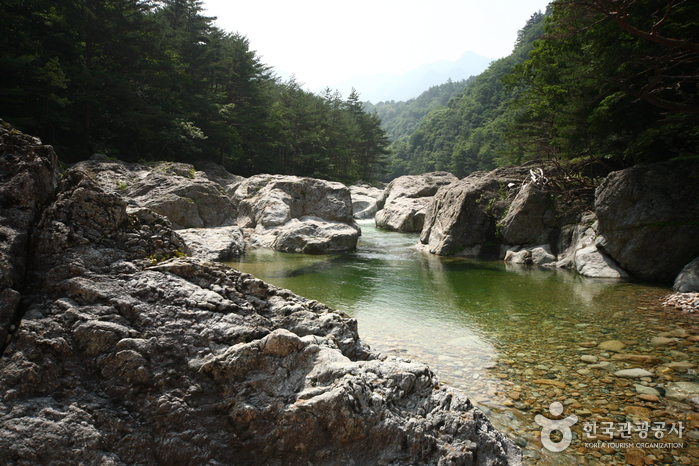
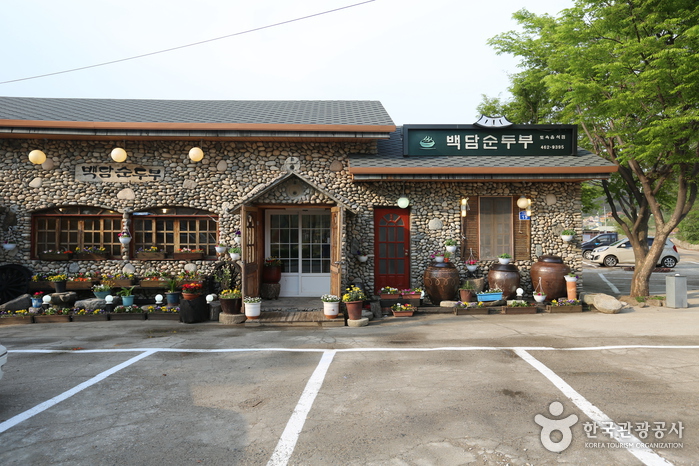
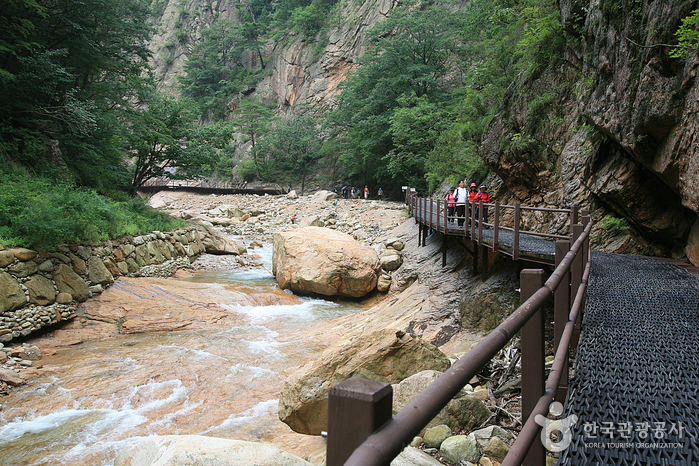
 English
English
 한국어
한국어 日本語
日本語 中文(简体)
中文(简体) Deutsch
Deutsch Français
Français Español
Español Русский
Русский